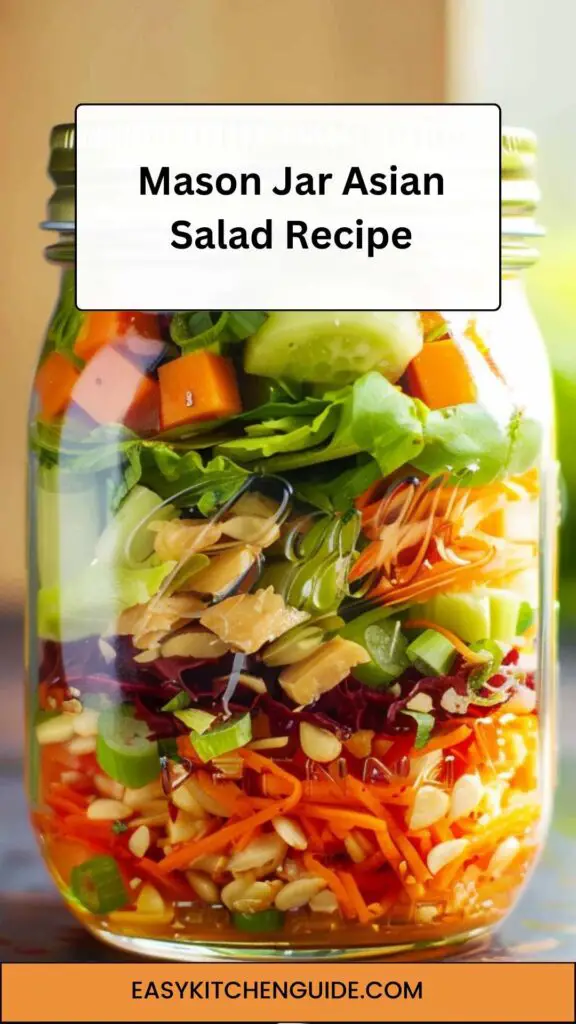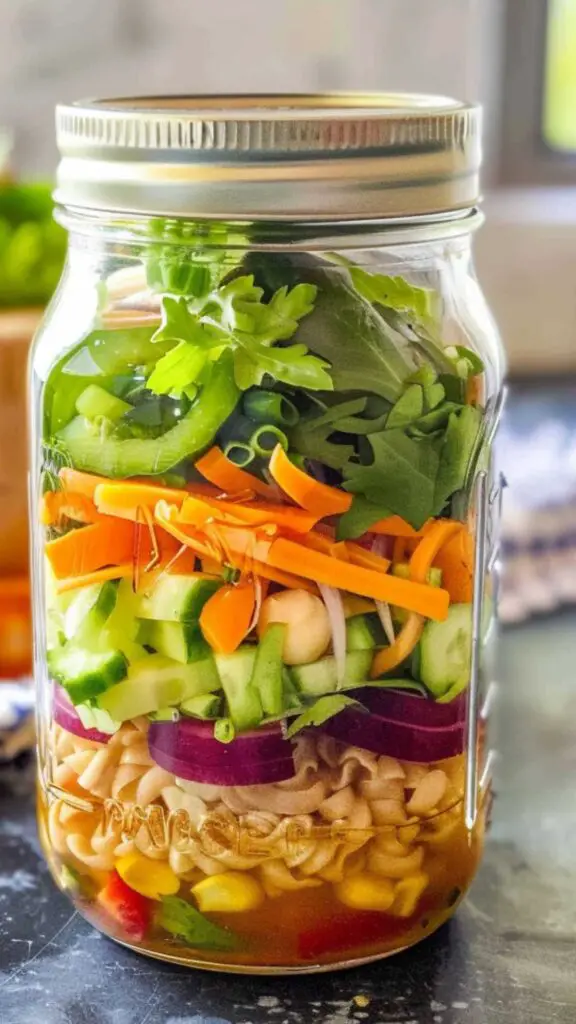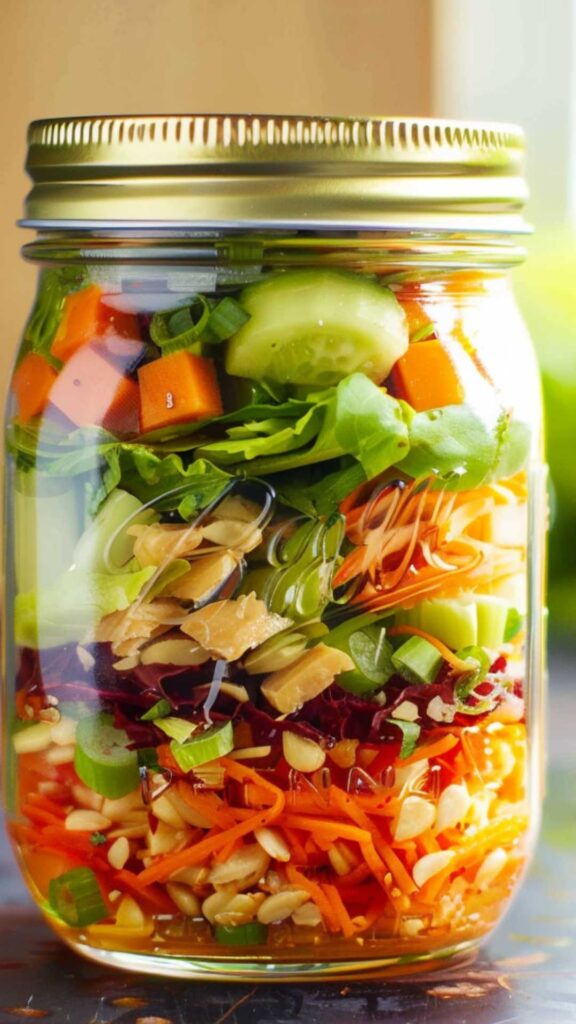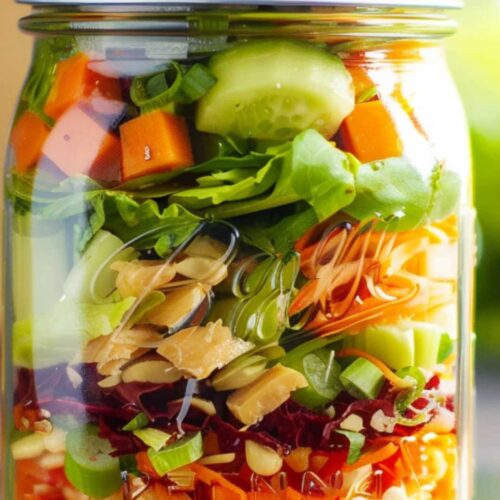As a food enthusiast who loves exploring different cuisines and flavors, I am always on the lookout for new and exciting recipes to try. Recently, I stumbled upon the concept of mason jar salads and was intrigued by the idea of creating a portable and visually appealing meal in a jar.
One recipe that caught my eye was the Mason Jar Asian Salad – a delightful combination of fresh ingredients, vibrant colors, and bold flavors that promise to tantalize the taste buds.
In this blog post, I will delve into what makes this recipe so special, provide a detailed list of ingredients, a step-by-step guide on how to make it, and share some tips and tricks to elevate your salad game.

What is Mason Jar Asian Salad?
Mason Jar Asian Salad is a visually stunning and delicious salad packed with a variety of colorful and nutritious ingredients that are layered in a mason jar to create a convenient and portable meal.
The key to this salad is the careful arrangement of ingredients in the jar, starting with the dressing at the bottom and layering sturdier ingredients like vegetables and proteins on top to prevent wilting or sogginess.
When ready to eat, simply shake the jar to distribute the dressing evenly and enjoy a flavorful and satisfying meal on the go.
Why This Recipe Works:
1. Convenience: The Mason Jar Asian Salad is a perfect meal prep option as it can be made in advance and stored in the refrigerator for several days. This makes it ideal for busy individuals or those looking to streamline their meal planning process.
2. Visual Appeal: The vibrant colors of the various vegetables used in this salad create an aesthetically pleasing presentation that is not only inviting but also Instagram-worthy.
3. Balanced Nutrition: With a mix of protein from the chicken and shrimp, fiber from the vegetables, and healthy fats from the dressing, this salad offers a well-rounded and nutritious meal that will keep you satisfied and energized.
4. Customizable: One of the best things about mason jar salads is that they are highly customizable. You can easily swap out ingredients based on your preferences or what you have on hand, making it a versatile and adaptable recipe for any palate.

Descriptive Ingredients:
- Cooked, cooled edamame: I used this vibrant and nutritious ingredient to add a boost of plant-based protein to the salad. Edamame not only enhances the salad’s nutritional profile but also contributes a satisfying texture and mild nutty flavor. Additionally, its vibrant green color adds visual appeal, making the salad even more enticing.
- Chopped bell pepper: Bell peppers add a crunchy texture and a pop of color to the salad. Their sweet and slightly tangy flavor complements the other ingredients well, providing a refreshing contrast to the richness of the protein and the earthiness of the vegetables. Plus, they’re packed with vitamin C and other essential nutrients, adding to the salad’s overall health benefits.
- Shredded red cabbage: I included shredded red cabbage for its vibrant color and crisp texture. Red cabbage not only adds visual interest to the salad but also provides a satisfying crunch and a mildly sweet flavor. It’s also rich in antioxidants and other beneficial nutrients, making it a nutritious addition to the dish.
- Chopped scallions: Scallions lend a mild onion flavor and a fresh, green crunch to the salad. Their delicate flavor adds depth to the overall taste profile without overwhelming the other ingredients. Plus, they provide a burst of color and freshness that enhances the salad’s visual appeal.
- Diced plum tomatoes: Plum tomatoes contribute juicy sweetness and a burst of vibrant color to the salad. Their acidity balances the richness of the protein and the creaminess of the dressing, adding a refreshing contrast to each bite. Plus, their firm texture holds up well in the salad, ensuring they remain satisfyingly crisp.
- Chopped fresh mint: Fresh mint adds a bright and refreshing flavor to the salad, awakening the palate with its cool, herbal notes. Its aromatic fragrance complements the other ingredients, adding depth and complexity to the overall taste experience. Plus, it adds a touch of elegance and sophistication to the dish, making it feel like a gourmet treat.
- Rotisserie chicken, chopped: I included rotisserie chicken for its convenience and savory flavor. The tender, juicy chicken adds protein and substance to the salad, making it more satisfying and hearty. Plus, its seasoned flavor enhances the overall taste profile, giving the salad a comforting and familiar appeal.
- Sriracha shrimp: Sriracha shrimp brings a spicy kick and a bold flavor to the salad. The tangy heat of the sriracha sauce pairs perfectly with the sweetness of the shrimp, creating a tantalizing flavor combination that’s sure to awaken the taste buds. Plus, shrimp adds lean protein and a delicate texture to the salad, making it even more delicious and satisfying.
- Julienned carrots: Carrots add sweetness, crunch, and vibrant color to the salad. Their natural sweetness balances the other flavors in the dish, while their crisp texture provides a satisfying bite. Plus, carrots are rich in vitamins and antioxidants, adding to the salad’s nutritional value.
- Chopped romaine lettuce: Romaine lettuce forms the base of the salad, providing a crisp and refreshing backdrop for the other ingredients. Its mild flavor and sturdy texture make it an ideal choice for salads, while its high water content adds hydration and volume to the dish. Plus, romaine lettuce is rich in vitamins and minerals, making it a nutritious addition to any meal.
- Sesame seeds: Sesame seeds add a nutty flavor and a satisfying crunch to the salad. They also contribute a hint of toasted aroma, enhancing the overall taste experience. Plus, sesame seeds are rich in healthy fats, protein, and essential nutrients, making them a nutritious and delicious addition to the dish.
- Sriracha: I used sriracha to add a spicy kick and a tangy flavor to the salad dressing. Its bold flavor profile complements the other ingredients, adding depth and complexity to the dressing. Plus, sriracha’s vibrant color adds visual appeal to the salad, making it even more enticing.
- Peanut butter: Peanut butter lends creaminess and richness to the salad dressing, creating a luscious and flavorful sauce. Its nutty flavor adds depth and complexity to the dressing, while its smooth texture helps to bind the ingredients together. Plus, peanut butter is a good source of healthy fats and protein, adding to the salad’s nutritional value.
- Grated fresh ginger: Fresh ginger adds a zesty kick and a warm, spicy flavor to the salad dressing. Its aromatic fragrance enhances the overall taste profile, adding depth and complexity to the dressing. Plus, ginger has anti-inflammatory and digestive health benefits, making it a nutritious and flavorful addition to the dish.
- Finely chopped garlic: Garlic contributes savory depth and pungent flavor to the salad dressing. Its aromatic fragrance enhances the overall taste profile, adding complexity and richness to the dressing. Plus, garlic has numerous health benefits, including immune-boosting and heart-healthy properties, making it a flavorful and nutritious addition to the dish.
- Rice wine vinegar: Rice wine vinegar adds a tangy and slightly sweet flavor to the salad dressing. Its mild acidity balances the richness of the other ingredients, adding brightness and freshness to the dressing. Plus, rice wine vinegar has a subtle flavor that complements the Asian-inspired ingredients in the salad, making it a perfect choice for the dressing.
- Olive oil: I used olive oil as the base of the salad dressing for its rich, fruity flavor and heart-healthy properties. Its smooth texture helps to emulsify the other ingredients, creating a creamy and luxurious dressing. Plus, olive oil adds a satisfying richness to the salad, making it more flavorful and enjoyable.
- Soy sauce: Soy sauce adds savory umami flavor and a hint of saltiness to the salad dressing. Its complex flavor profile enhances the other ingredients, adding depth and richness to the dressing. Plus, soy sauce is a versatile ingredient that complements a wide range of flavors, making it an essential component of the salad dressing.
How To Make These?
Step 1: Prepare the Dressing
Gather all the ingredients needed for making the dressing.
In a small bowl, combine the gathered dressing ingredients.
Using a whisk or spoon, blend the ingredients together until they are fully combined and the dressing is smooth.
Step 2: Organize Mason Jars
Ensure that four Mason jars are clean and thoroughly dried.
Step 3: Distribute the Dressing
Divide the prepared dressing evenly among the four Mason jars, pouring it into the bottom of each jar.
Step 4: Layer the Salad Components
Layer the salad components into each jar in the specified order: cooked and cooled edamame, chopped bell pepper, shredded red cabbage, chopped scallions, diced plum tomatoes, chopped fresh mint, chopped rotisserie chicken, sriracha shrimp, julienned carrots, chopped romaine lettuce, and sesame seeds.
Step 5: Seal the Jars
Securely place the lids on each Mason jar, ensuring they are tightly sealed to prevent any leakage.
Step 6: Refrigerate
Store the sealed jars upright in the refrigerator until you’re ready to enjoy the salad. Keeping them upright helps maintain the integrity of the layers and prevents the dressing from saturating the salad prematurely.
Step 7: Shake and Serve
When you’re ready to eat, remove a jar from the refrigerator, and give it a good shake to evenly distribute the dressing and ingredients. Open the jar and savor your delicious mason jar Asian salad!
Tips:
1. To prevent sogginess, layer the dressing at the bottom of the jar and the sturdier ingredients at the top.
2. Use a wide-mouth mason jar for easy assembly and serving.
3. Customize the salad by swapping out ingredients or adjusting the spice level of the dressing to suit your taste preferences.
4. Make a batch of mason jar salads at the beginning of the week for quick and convenient meals throughout the week.
5. Experiment with different protein options such as tofu, grilled pork, or beef to add variety to your salads.

Nutrition Information:
– Calories: 210
– Total Fat: 18g
– Saturated Fat: 3g
– Cholesterol: 70mg
– Sodium: 500mg
– Total Carbohydrates: 25g
– Dietary Fiber: 8g
– Sugars: 8g
– Protein: 25g
How to Store The Leftovers?
To store any leftover mason jar salads, simply ensure that the lid is tightly sealed and store them in the refrigerator for up to 3-4 days. When ready to eat, shake the jar to distribute the dressing evenly before serving.
What are some recommended side dishes for Mason Jar Asian Salad?
1. Steamed Jasmine Rice: Pairing the salad with a side of aromatic jasmine rice adds a hearty and comforting element to the meal.
2. Crispy Vegetable Spring Rolls: These light and crunchy spring rolls complement the fresh flavors of the salad perfectly.
3. Chilled Soba Noodles: A refreshing and cold noodle salad makes for a satisfying and filling side dish to enjoy with the mason jar salad.
4. Coconut Lemongrass Soup: A warm and fragrant bowl of coconut lemongrass soup provides a contrast in flavors that pairs well with the salad.
If the items are not available in your pantry, what are some substitute options for the ingredients?
1. Protein: Substitute the rotisserie chicken with grilled tofu or marinated tempeh for a vegetarian option.
2. Shrimp: Replace the sriracha shrimp with cooked and seasoned chickpeas or sliced seitan for a plant-based alternative.
3. Vegetables: Feel free to swap out any of the vegetables with your favorites such as cucumber, kale, snap peas, or radishes for a different flavor profile.
4. Dressing: If you’re out of ingredients for the dressing, you can use a store-bought Asian sesame dressing or a simple vinaigrette flavored with soy sauce and sesame oil as a substitute.

Mason Jar Asian Salad Recipe
Equipment
Ingredients
For Salad:
- ½ cup cooked cooled edamame
- ½ cup chopped bell pepper
- 1 cup shredded red cabbage
- 2 scallions chopped
- 4 plum tomatoes diced
- 2 teaspoons chopped fresh mint
- ½ cup rotisserie chicken chopped
- ½ cup sriracha shrimp
- ½ cup carrots julienned
- 1 cup of romaine lettuce chopped
- 1 teaspoon sesame seeds
Instructions
Step 1: Prepare The Dressing
- Gather all the ingredients needed for making the dressing.
- In a small bowl, combine the gathered dressing ingredients.
- Using a whisk or spoon, blend the ingredients together until they are fully combined and the dressing is smooth.
Step 2: Organize Mason Jars
- Ensure that four Mason jars are clean and thoroughly dried.
Step 3: Distribute The Dressing
- Divide the prepared dressing evenly among the four Mason jars, pouring it into the bottom of each jar.
Step 4: Layer The Salad Components
- Layer the salad components into each jar in the specified order: cooked and cooled edamame, chopped bell pepper, shredded red cabbage, chopped scallions, diced plum tomatoes, chopped fresh mint, chopped rotisserie chicken, sriracha shrimp, julienned carrots, chopped romaine lettuce, and sesame seeds.
Step 5: Seal The Jars
- Securely place the lids on each Mason jar, ensuring they are tightly sealed to prevent any leakage.
Step 6: Refrigerate
- Store the sealed jars upright in the refrigerator until you’re ready to enjoy the salad. Keeping them upright helps maintain the integrity of the layers and prevents the dressing from saturating the salad prematurely.
Step 7: Shake And Serve
- When you’re ready to eat, remove a jar from the refrigerator, and give it a good shake to evenly distribute the dressing and ingredients. Open the jar and savor your delicious mason jar Asian salad!
Notes
- To prevent sogginess, layer the dressing at the bottom of the jar and the sturdier ingredients at the top.
- Use a wide-mouth mason jar for easy assembly and serving.
- 3. Customize the salad by swapping out ingredients or adjusting the spice level of the dressing to suit your taste preferences.
- Make a batch of mason jar salads at the beginning of the week for quick and convenient meals throughout the week.
- Experiment with different protein options such as tofu, grilled pork, or beef to add variety to your salads.
Frequently Asked Questions:
Q1: Can I prepare the Mason Jar Asian Salad in advance?
A1: Yes, you can assemble the salads in advance and store them in the refrigerator for up to 3-4 days for a quick and convenient meal option.
Q2: Can I use a different type of protein in the salad?
A2: Absolutely! You can customize the salad by using grilled tofu, beef, pork, or even canned tuna as alternative protein options.
Q3: How do I prevent the ingredients from getting soggy in the jar?
A3: Layering the dressing at the bottom of the jar and placing sturdier ingredients like proteins and vegetables on top will help prevent sogginess and keep the salad fresh.
Q4: Can I double the recipe to make more servings?
A4: Of course! Simply adjust the quantities of the ingredients based on the number of servings you wish to make and assemble them in individual mason jars for easy storage.
Q5: Can I warm up the Mason Jar Asian Salad before eating?
A5: While the salad is typically enjoyed cold, you can remove it from the refrigerator and let it come to room temperature before eating if you prefer a slightly less chilled meal.
Conclusion:
In conclusion, Mason Jar Asian Salad is not only a visually appealing and convenient meal option but also a flavorful and nutritious recipe that is sure to become a favorite in your weekly meal rotation.
With its versatility, customizability, and portability, this salad offers a delightful dining experience whether you’re on the go or enjoying a leisurely meal at home.
So, grab your mason jars, gather your ingredients, and embark on a culinary journey full of vibrant colors, bold flavors, and wholesome goodness with this delectable Mason Jar Asian Salad.
You’ll also like the latest recipes!
- Donut With Almond Topping Copycat Recipe
- Blueberry Cheesecake French Toast
- How to Make Costco Pumpkin Pie Recipe
My name is Lori Walker. I’m a registered dietitian, food blogger and food enthusiast. I share easy healthy, delicious recipes on my blog and review necessary kitchen items. The recipes I share take less… Read more
